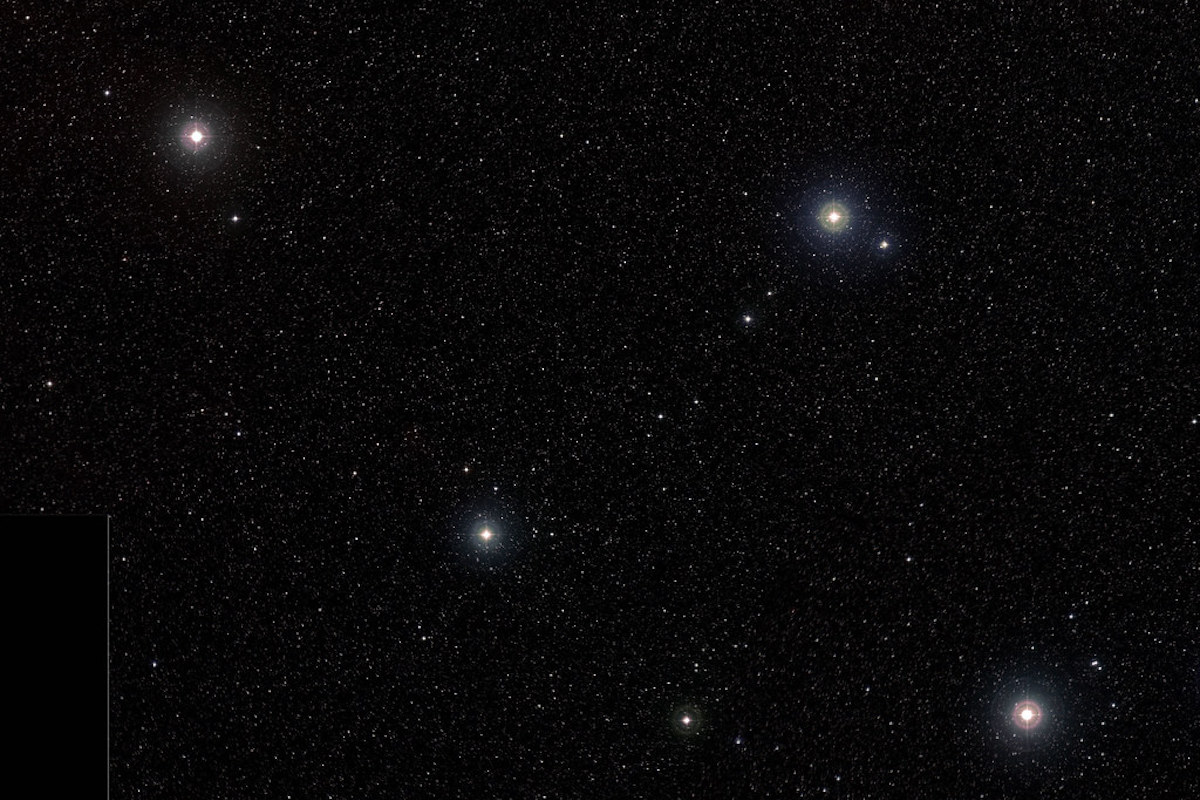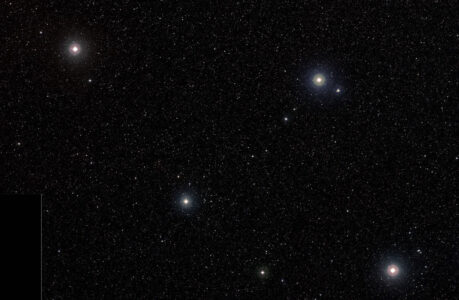The Delphinus constellation is a small but captivating group of stars that has fascinated stargazers for centuries. Known as the celestial dolphin, it is one of the smallest constellations in the sky but is packed with a rich history and mythology. If you’re based in Ireland and want to explore the wonders of the night sky, Delphinus is an excellent place to start. In this article, we’ll take a closer look at the Delphinus constellation, its history, mythology, and how to view it from Ireland.
Overview of Delphinus
Delphinus is a small constellation located in the northern hemisphere, between the constellations of Aquila and Cygnus. It is one of the 48 constellations listed by the Greek astronomer Ptolemy in the 2nd century AD. Delphinus is also one of the few constellations that resemble its namesake animal, a dolphin, which is believed to be a messenger of the sea god Poseidon.
The constellation is made up of five main stars, arranged in the shape of a diamond, with a sixth star nearby that is also visible to the naked eye. The brightest star in the group is called Alpha Delphini, which translates to “the leader of the dolphin.” It has a magnitude of 3.8, making it visible even in light-polluted areas.
Mythology of Delphinus
In Greek mythology, Delphinus is associated with the story of Arion, a poet and musician who was saved by a dolphin after being thrown overboard by pirates. According to the legend, Arion was sailing home to Greece from a musical competition in Sicily when he was attacked by pirates. After being robbed and thrown overboard, Arion was rescued by a friendly dolphin who carried him to safety on the shores of Corinth.
As a tribute to the dolphin that saved him, Arion created a hymn in honor of the sea creature. The story of Arion and the dolphin became so popular that it eventually became associated with the Delphinus constellation.
Viewing Delphinus from Ireland
Delphinus is visible from Ireland during the summer months, between June and August. During this time, the constellation can be seen in the southern part of the sky, near the horizon. To spot Delphinus, look for a small diamond shape made up of five stars, with a sixth star nearby.
The best time to view Delphinus is during a new moon when the sky is darkest. It’s recommended to find a location away from artificial light sources such as streetlights or buildings to get the best view of the constellation. If possible, bring a pair of binoculars or a small telescope to get a closer look at the stars and their patterns.
The Delphinus constellation is a captivating and fascinating group of stars that offers a glimpse into ancient mythology and history. As one of the smallest constellations in the sky, it’s easy to overlook, but its beauty and symbolism make it worth exploring. If you’re based in Ireland and want to view Delphinus, head out on a clear summer night and look towards the southern horizon. With a bit of luck and patience, you’ll be rewarded with a stunning view of the celestial dolphin.
How can I see the constellation of Delphinus from Ireland?
To see the Delphinus constellation from Ireland, you need to know when and where to look in the sky. Here are some tips to help you spot this celestial dolphin:
- Time of year: The best time to view Delphinus from Ireland is during the summer months, between June and August. During this time, the constellation can be seen in the southern part of the sky, near the horizon.
- Location: Find a location away from artificial light sources such as streetlights or buildings to get the best view of the constellation. If you can, head out to a rural area where the sky is darkest.
- Look for the diamond shape: To spot Delphinus, look for a small diamond shape made up of five stars, with a sixth star nearby. This shape is the main feature of the constellation and is relatively easy to identify.
- Use binoculars or a telescope: If possible, bring a pair of binoculars or a small telescope to get a closer look at the stars and their patterns. This can help you spot the more faint stars in the constellation that might be difficult to see with the naked eye.
Remember to be patient and give your eyes time to adjust to the darkness. It may take a few minutes for your eyes to adapt fully, but once they do, you’ll be able to see more stars and details in the night sky, including the Delphinus constellation.
The mythology of the constellation of Delphinus
The mythology of the Delphinus constellation is rich and varied, with different stories and legends associated with it throughout history. In Greek mythology, the constellation represents a dolphin that was sent by the sea god Poseidon to search for the nymph Amphitrite, whom he wanted to marry. The dolphin found Amphitrite and convinced her to marry Poseidon, which pleased the god greatly. As a reward, Poseidon placed the image of the dolphin in the night sky as a constellation.
Another myth associated with Delphinus is the story of Arion, a poet and musician who was saved by a dolphin after being thrown overboard by pirates. According to the legend, Arion was sailing home to Greece from a musical competition in Sicily when he was attacked by pirates. After being robbed and thrown overboard, Arion was rescued by a friendly dolphin who carried him to safety on the shores of Corinth. As a tribute to the dolphin that saved him, Arion created a hymn in honor of the sea creature. The story of Arion and the dolphin became so popular that it eventually became associated with the Delphinus constellation.
In ancient times, the Delphinus constellation was also associated with the goddess Aphrodite, who was often depicted riding on the back of a dolphin. The Greeks believed that dolphins were sacred to Aphrodite and represented fertility, love, and joy. They even used dolphins in their religious ceremonies and artwork, and some ancient Greek coins even depicted a dolphin on one side.
Overall, the mythology of the Delphinus constellation reflects the ancient Greeks’ fascination with the sea and its creatures, as well as their desire to understand and interpret the natural world through myth and legend. Today, the constellation remains a symbol of beauty, grace, and intelligence, and continues to inspire stargazers around the world.
The Stars in the constellation of Delphinus
The Delphinus constellation is made up of several stars, with five main stars that form the shape of a diamond and a sixth nearby star that is also visible to the naked eye. Here are some of the key stars in Delphinus:
- Alpha Delphini: Also known as Sualocin, Alpha Delphini is the brightest star in the Delphinus constellation. It has a magnitude of 3.8 and is located at the head of the diamond shape. The name “Sualocin” is actually “Nicolaus” spelled backwards, in honor of the Italian astronomer Nicolaus Venator who discovered the star in the 17th century.
- Beta Delphini: Also known as Rotanev, Beta Delphini is the second-brightest star in the constellation. It has a magnitude of 3.6 and is located at the tail of the diamond shape. The name “Rotanev” is “Venator” spelled backwards, in honor of Nicolaus Venator.
- Gamma Delphini: Gamma Delphini is a binary star system located at the tip of the dolphin’s nose. It has a magnitude of 4.4 and consists of two stars orbiting each other.
- Delta Delphini: Delta Delphini is a double star system located at the base of the dolphin’s tail. It has a magnitude of 4.4 and consists of two stars that are close together and appear as a single point of light.
- Epsilon Delphini: Epsilon Delphini is located near the dolphin’s back and has a magnitude of 4.0. It is a triple star system that consists of two stars that orbit each other and a third star that is much farther away.
Overall, the stars in the Delphinus constellation are relatively bright and easy to spot, even in light-polluted areas. They offer a great opportunity for stargazers to explore the night sky and appreciate the beauty and wonder of the cosmos.
Deep sky objects visible in the Constellation of Delphinus
While the Delphinus constellation is relatively small, it contains a few deep-sky objects that are worth exploring for stargazers with telescopes or binoculars. Here are some of the deep-sky objects that can be seen in the Delphinus constellation:
NGC 6891 is a planetary nebula located in the western part of the constellation. It has a magnitude of 11.5 and appears as a faint greenish-blue disc in telescopes. This planetary nebula is relatively small, with a diameter of only 0.6 light-years.
NGC 6905 is another planetary nebula located near the eastern border of Delphinus. It has a magnitude of 10.5 and appears as a small, bright disc in telescopes. This planetary nebula is sometimes referred to as the “Blue Flash Nebula” due to its bluish color.
Stephenson 2-18 is an open cluster located in the southern part of Delphinus. It has a magnitude of 11.1 and contains around 100 stars. This open cluster is relatively young, with an estimated age of around 25 million years.
IC 4699 is another open cluster located in the northern part of the constellation. It has a magnitude of 8.7 and contains around 50 stars. This open cluster is relatively large, with a diameter of around 20 light-years.
IC 4765 is a faint open cluster located near the border between Delphinus and Sagitta. It has a magnitude of 9.5 and contains around 40 stars. This open cluster is relatively distant, with an estimated distance of around 4,500 light-years.

